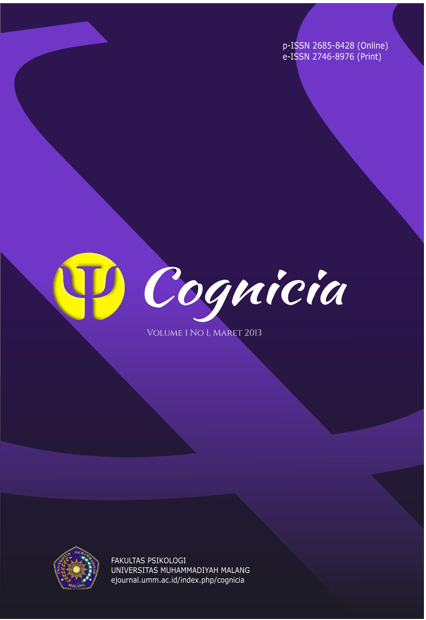SELF EFFICACY DENGAN KECEMASAN DALAM MENGHADAPI UJIAN NASIONAL
DOI:
https://doi.org/10.22219/cognicia.v1i1.1441Abstract
Keyakinan seseorang akan kemampuannya untuk mencapai tujuan (Self efficacy) diperlukan siswa untuk dapat menghadapi Ujian Nasional (UN) dengan baik. Penelitian ini bertujuan untuk mengetahui hubungan self efficacy dengan kecemasan dalam menghadapi ujian nasional. Jenis penelitian ini adalah penelitian kuantitatif. Subjek dalam penelitian ini 70 siswa SMK kelas 3. Metode pengumpulan data adalah skala, dengan skala likert. Metode analisa data adalah korelasi product moment. Hasil penelitian menunjukkan koefisien korelasi (r) sebesar -0,615dan (p) = 0,000 hal ini menandakan adanya hubungan negatif yang sangat signifikan antara variabel self efficacy dengan variabel kecemasan. Hal ini berarti apabila self efficacy tinggi maka kecemasan menghadapi ujian nasional rendah, dan sebaliknya jika nilai self efficacy rendah maka kecemasan dalam menghadapi ujian nasional tinggi. Nilai koefisien determinan ( ) = 0,378, yang bermakna bahwa variabel self efficacy mampu menjelaskan variabel kecemasan menghadapi ujian nasional sebesar 37,8%, sisanya sebesar 62,2% dipengaruhi oleh variabel lain.
Kata kunci: Self efficacy, Kecemasan
a person's belief in his/her ability to achieve the goals is need student to convince the students could face the national examination well because students sometime get an anxiety in facing the national examinations. Otherwise, if the students have high self-efficacy then the students will have low anxiety because those students are already convinced of their ability. The purpose of this study is to determine the relationship of self-efficacy with the anxiety of facing national examinations. The type of this research is quantitative research. The populations in this study are the students of 3rd grade of vocational school. The methods of collecting the data is scale, by using Likert scale. While the method of data analysis used product moment correlation..Based on the data analysis, it obtained that the correlation of coefficient (r) is -0.615 and (p) = 0.000 it indicates that there is a relationship of negative direction which very significant between self-efficacy variable with the anxiety variable. This means if the self-efficacy is high so the anxiety of facing national exams is low and the vice versa if the value of self-efficacy is low, the anxiety of facing national exam is high. The value of determinant coefficient (R2) = 0.378, which means that the self-efficacy variable could explain the anxiety variable of facing national exams at 37.8%, the other is 62.2% influenced by other.
Keywords: Self-efficacy, Anxiety
Downloads
Downloads
Published
How to Cite
Issue
Section
License
Copyright (c) 1970 Harfiahana Puspa Rini

This work is licensed under a Creative Commons Attribution-ShareAlike 4.0 International License.
Authors who publish with Jurnal Cognicia agree to the following terms:
- For all articles published in Jurnal Cognicia, copyright is retained by the authors. Authors give permission to the publisher to announce the work with conditions. When the manuscript is accepted for publication, the authors agree to automatic transfer of the publishing right to the publisher.
- Authors retain copyright and grant the journal right of first publication with the work simultaneously licensed under a Creative Commons Attribution-ShareAlike 4.0 International License that allows others to share the work with an acknowledgment of the work's authorship and initial publication in this journal.
- Authors are able to enter into separate, additional contractual arrangements for the non-exclusive distribution of the journal's published version of the work (e.g., post it to an institutional repository or publish it in a book), with an acknowledgment of its initial publication in this journal.
- Authors are permitted and encouraged to post their work online (e.g., in institutional repositories or on their website) prior to and during the submission process, as it can lead to productive exchanges, as well as earlier and greater citation of published wor (See The Effect of Open Access).

This work is licensed under a Creative Commons Attribution-ShareAlike 4.0 International License







